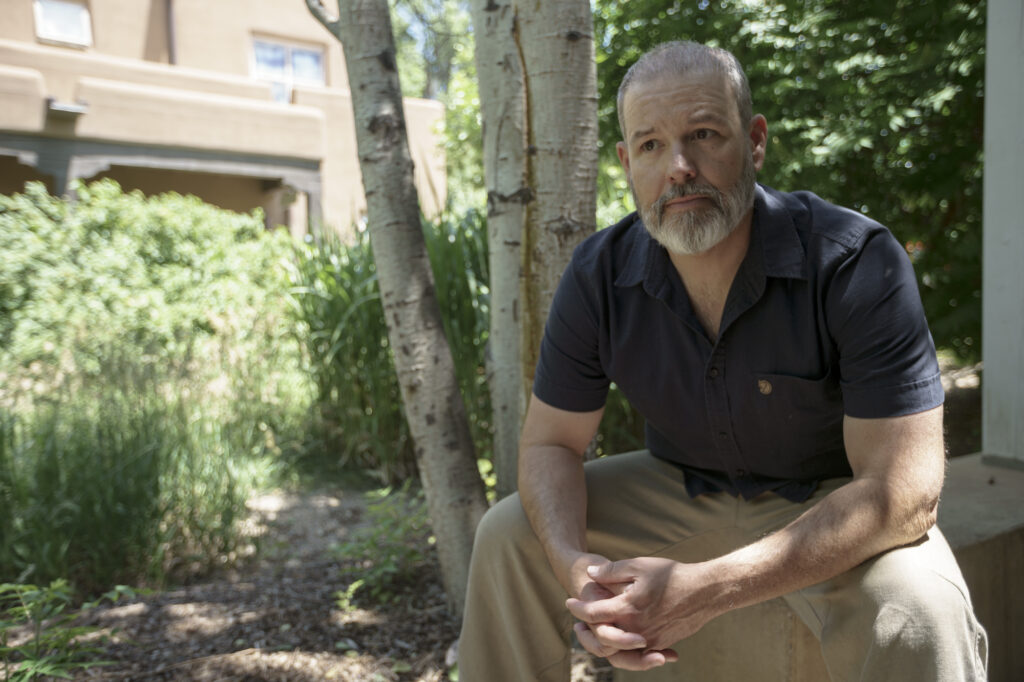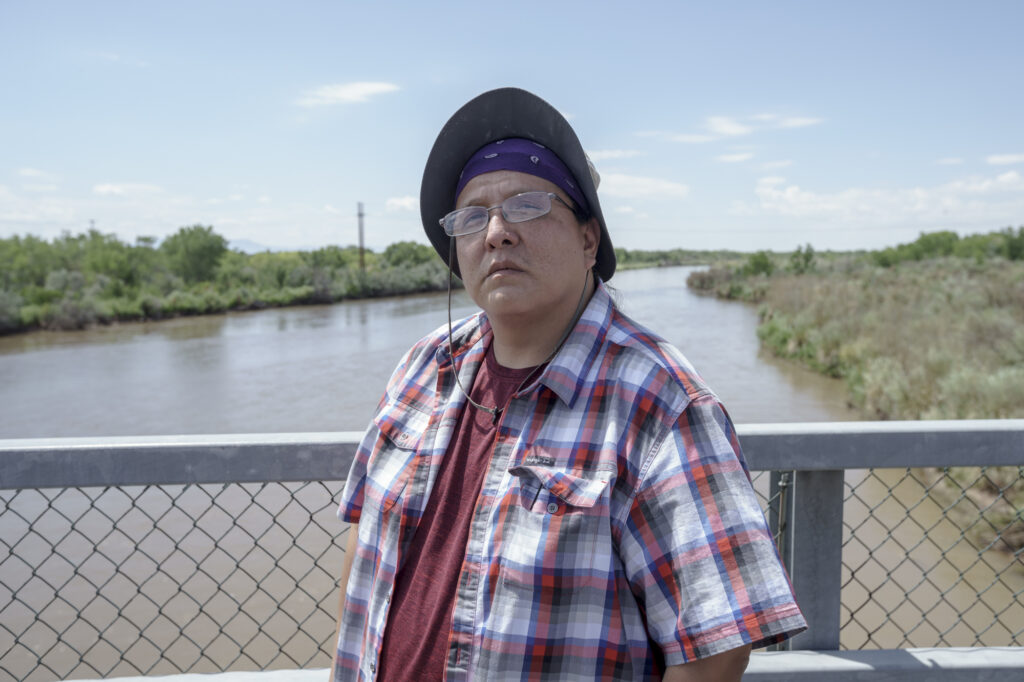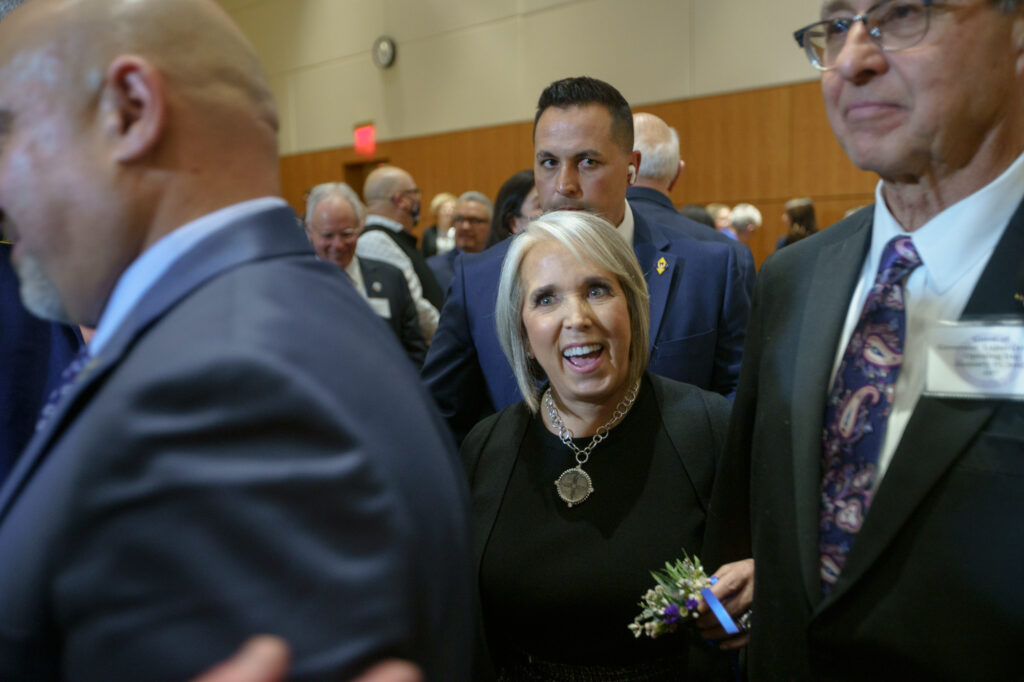by Jeremiah O. Rhodes / Searchlight NM
When Gov. Michelle Lujan Grisham took office in 2019, she made big promises about reducing greenhouse gas emissions and embracing clean energy – a radical objective, considering that the state relies on the oil and gas industry for a third of its revenue.
Four years later, the oil and gas sector continues to exert enormous influence across the state, the harmful effects of climate change are altering life for New Mexicans and Lujan Grisham has been named in a lawsuit that accuses her and others of failing to protect citizens’ rights to clean air, water and land.
So why was Lujan Grisham honored recently with a position on the executive committee of the U.S. Climate Alliance, a coalition of governors who are considered the nation’s environmental leaders? Given that the alliance is intended for lawmakers who make “real, impactful, on-the-ground” actions to address climate change, environmental advocates in New Mexico are wondering if she deserves the role.
“When folks saw she had been appointed to the committee, I think there was a sense of real frustration,” said Erik Schlenker-Goodrich, executive director of the Western Environmental Law Center, a public interest environmental law firm. Lujan Grisham’s appointment, he said, is indicative of a “glaring mismatch between what her apparent reputation on climate was nationally and what is really happening within the state.”
Gail Evans, the lead counsel in a lawsuit asserting that New Mexico’s environmental degradation is unconstitutional, put it bluntly: “The governor has absolutely no business being a member of a climate leadership group.” Evans, an attorney with the Center for Biological Diversity, said Lujan Grisham might have plans and talking points for speeches, but hasn’t produced results.
“Her administration has put in place rules that are supposed to control methane emissions and ozone precursors,” she noted. “And yet those rules haven’t led to a reduction in these dangerous emissions. Instead, these emissions are at all-time highs. And that’s because these rules are not being enforced.”
Leaders like Lujan Grisham “undermine the potential efficacy of that alliance,” said Mariel Nanasi, the executive director of New Energy Economy, a nonprofit that advocates for clean energy transitions and environmental justice.
When asked about Lujan Grisham’s executive committee appointment, Caroline Sweeney, a spokesperson for the governor, referred Searchlight New Mexico to the U.S. Climate Alliance. “The alliance would be better suited” to respond to questions, given that the group appointed Lujan Grisham to the role, Sweeney said.
The alliance, for its part, said the governor was selected because, since joining in 2019, she’s proven herself a leader in climate stewardship. Evan Westrup, an alliance spokesperson, explained in an email that Lujan Grisham was chosen by the coalition’s members, including the governors of 24 states and Guam.
Alliance members aim to reach net-zero greenhouse gas emissions in their states no later than 2050 and to meet the goals of the Paris Agreement, the landmark international climate treaty.
“Since joining the Alliance, Gov. Lujan Grisham has been a standout and in this role, we expect she’ll continue to lead by example, share impactful solutions with other states and territories, and work in partnership with the federal government to help secure our net-zero future,” Westrup wrote.

A tall order
In 2019, less than a month after taking office, Lujan Grisham issued an executive order that, as she described it, would mark “an important shift in direction on climate policy in New Mexico.”
The executive order contained a slew of directives intended to “build a clean energy future for our people.” The goal: To “limit adverse climate change impacts,” reduce harm to the state’s natural and cultural heritage, prevent the waste of energy resources and “reduce pollution that threatens human health.”
It was a tall order, and it was met with fanfare from environmental groups, activists and national leaders, who praised Lujan Grisham for her bold action in a state with deep ties to the oil and gas industry.
“There was immense optimism that New Mexico would be leaning into climate action and, in particular, to a just transition away from fossil fuels and toward renewable energy and sustainable economic development,” said Schlenker-Goodrich.
To him and other advocates, this felt like a much-needed departure from the policies of previous Gov. Susana Martinez, who had halted regulations aimed at cutting greenhouse gas emissions and fired the entire Environmental Improvement Board after it approved regulations that would regulate emissions.
Today, however, the optimism about Lujan Grisham has faded, leaving a sentiment of disappointment and frustration amongst activists and environmentalists.
“She’s not working for us,” Nanasi said. “The facts don’t bear out that she’s a leader in addressing climate change.”

When things started to sour
Schlenker-Goodrich remembers when his own optimism started to dissipate: It was when the governor began pushing for a hydrogen hub, a concept that on its face calls for reduced greenhouse gas emissions but that actually can increase emissions — and end up hurting the environment more than helping.
Positioning hydrogen as a low-emission fuel option is controversial among politicians, scientists and activists across the country. In 2021, a coalition of organizations – including the Western Environmental Law Center – sent a letter to Lujan Grisham, calling the race toward hydrogen a “distraction” from real climate solutions such as carbon emission limits. Pursuing a hydrogen economy, the groups stated, would “further entrench fossil fuel interests and perpetuate volatile boom-bust oil and gas cycles.”
There are three main types of hydrogen production – gray, blue and green – and green hydrogen, the cleanest method, is the only one that relies solely on renewable sources, such as wind or solar. Green hydrogen, however, requires splitting molecules in fresh water — a resource that New Mexico famously lacks.
Many proposed projects in the state instead focus on blue hydrogen, a method that involves the use of natural gas and can result in increased methane emissions.
Constitutional violations alleged
In May, a coalition of nonprofits and community members filed a lawsuit against a wide array of parties in the state, including Lujan Grisham, for failing to protect New Mexicans’ constitutional rights to safe land, air, water and natural resources. The coalition, which calls itself NM LAWS (Land, Air, Water and the Sacred), asserts that the state’s refusal to establish and enforce environmental regulations has caused particular harm to Indigenous peoples, youths and “frontline community members” who live near oil and gas production sites.
Among the 15 plaintiffs are Paul, Mary Ann and Mario Atencio, members of a Diné family who describe a 2019 toxic waste and crude oil spill that contaminated their water and land and poisoned their livestock in the Counselor Chapter on the Navajo Nation.
Other plaintiffs include families who live in and around Chaco Canyon, where today’s residents suffer the health effects of extensive oil and gas development in the region, the complaint says. Children in Counselor are forced to attend school in nearby Cuba, New Mexico, “to get away from the air pollution and other dangers created by oil and gas production sites,” the lawsuit asserts.
The environmental nonprofit WildEarth Guardians reported an average of four toxic spills in New Mexico per day in 2022, totaling over 1,400 spills. Data from the Center for Western Priorities shows that New Mexico had more spills than Wyoming and Colorado — two of the country’s highest oil and gas-producing states — combined.

Record oil production, more emissions
Lujan Grisham’s environmental standing amongst New Mexicans has also been complicated by the state’s record-breaking oil production — which, almost by definition, translates to increased greenhouse gas emissions. March 2023 saw an almost 200 percent increase in oil production compared to March 2018, the year before Lujan Grisham took office.
To make matters worse, attempts to curb the oil and gas industry’s greenhouse gas emissions have proven difficult to enforce.
Last year, for example, the New Mexico Environment Department implemented an ambitious rule to substantially reduce the annual amounts of hazardous “ozone precursor pollutants” and methane released into the air by oil and gas operations. A complimentary rule issued in 2021 by the Energy, Minerals and Natural Resources Department aimed to curb methane emissions by limiting the venting and flaring of natural gas.
Unfortunately, the NMED and New Mexico’s Oil Conservation Division, two bodies responsible for enforcing emissions standards, lack the resources to adequately monitor well sites and apply penalties.
In lieu of effective enforcement strategies, polluters are left to police themselves, leading to underreporting and inaction.
New Mexico simply won’t be able to meet its climate goals unless it requires its largest air polluters to cut more greenhouse gas emissions, according to a study released in February by the University of New Mexico and PSE Healthy Energy, a nonprofit research institute. “Current state policies stop short” of combating climate change and improving local health because they don’t effectively enforce reduced emissions standards regarding power plants, oil refineries, gas processing plants and other major polluters, the report found.
Many of the largest polluters are located in areas where residents are predominantly low-income families and people of color, the report noted. When they are exposed to toxic air pollutants, the results can be devastating, leading to adverse health outcomes.
But of all the recent incidents that characterize Lujan Grisham’s support for the oil and gas industry, few felt as emblematic as her 2021 letter to President Joe Biden after he announced a moratorium on oil and gas leasing on federal lands. While the governor said she supported the action, she asked Biden to exempt New Mexico, stating that the moratorium would cause too much economic harm.
In truth, Lujan Grisham inherited a unique problem: It was always going to be difficult to turn one of the nation’s top oil-producing states into an environmental leader.
As Lujan Grisham stated in her letter to Biden, oil and gas money supports schools, infrastructure and — ironically — environmental initiatives. Be that as it may, advocates say she has blocked reforms instead of embracing them.
This year, she vetoed five climate-related measures in a proposed tax package, stating in her veto message that she had “grave concerns” about the sustainability of the package as a whole.
The measures included tax credits to help low-income New Mexicans buy electric vehicles, a fund for geothermal development and tax credits for residents to invest in zero-carbon-emission energy storage systems.
While environmentalists were aware that those tax measures wouldn’t “save the world,” as Schlenker-Goodrich put it, they were hopeful that they would at least propel some climate action across the state.
In response to the governor’s inaction, the environmental group ProgressNow New Mexico released a series of advertisements that rebuke her for “broken promises.” “Gov. Michelle Lujan Grisham promised to act on climate change for New Mexico’s future — where is she now?” as one ad puts it.

Non-binding U.S. goals
The U.S. Climate Alliance was formed in 2017, when the governors of California, Washington state and New York united in response to former President Donald Trump’s decision to withdraw from the Paris Agreement, a legally binding treaty — signed by nearly 200 countries — with specific goals to address climate change.
The U.S. Climate Alliance, by comparison, does not involve a legally binding agreement, meaning there are no consequences if member states fail to meet climate goals. New Mexico joined at the start of Lujan Grisham’s tenure as governor.
As co-chair of the executive committee, she will be expected to oversee “the strategic direction of the coalition,” the group’s website states.
Bill Holland, the vice president of state policy and advocacy with the League of Conservation Voters, hopes the governor’s new role will push her to deliver on key issues.
“The U.S. Climate Alliance has been a really strong body for governors to trade policies, to strategize and really to compete with each other,” Holland said. In the best-case scenario, it offers an opportunity “to make sure New Mexico trades best practices with governors across the country on how to center racial justice and how to allow communities to play a role in enacting policy.”
All anyone can do at this point is wait, he said, and hope for the best.
Jeremiah O. Rhodes
Jeremiah O. Rhodes is a Searchlight editorial intern and a dean’s merit fellow at the UC Berkeley Graduate School of Journalism, where he’s focusing on data reporting and web development. Rhodes received… More by Jeremiah O. Rhodes
